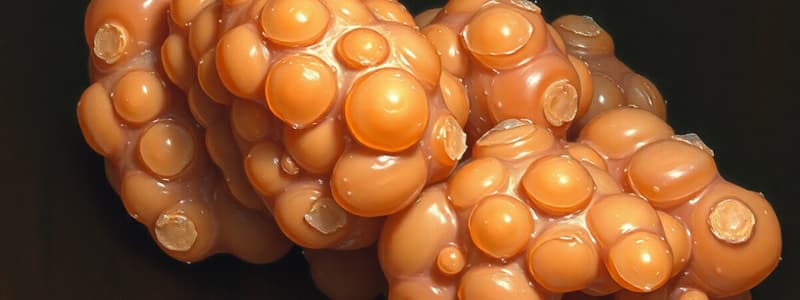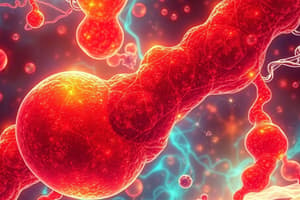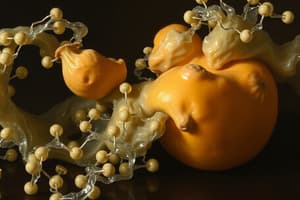Podcast
Questions and Answers
What is the primary function of epinephrine in the mobilization of triacylglycerols stored in adipose tissue?
What is the primary function of epinephrine in the mobilization of triacylglycerols stored in adipose tissue?
- It directly hydrolyzes triglycerides into fatty acids.
- It activates glycolysis for energy production.
- It converts fatty acids to acetyl CoA for energy.
- It stimulates adenylyl cyclase to produce cAMP. (correct)
Which step must occur prior to the oxidation of fatty acids in the mitochondria?
Which step must occur prior to the oxidation of fatty acids in the mitochondria?
- Fatty acids must be converted into glucose.
- Fatty acids must combine with glycerol.
- Fatty acids need to be converted into lactate.
- Fatty acids must be activated and transported into mitochondria. (correct)
What is the primary product generated from one round of beta-oxidation of saturated fatty acids?
What is the primary product generated from one round of beta-oxidation of saturated fatty acids?
- Glycerol and free fatty acids
- Glucose
- Acetyl CoA only
- NADH and FADH2 (correct)
How many ATP are generated from the complete oxidation of palmitic acid (C16) after accounting for the carnitine activation step?
How many ATP are generated from the complete oxidation of palmitic acid (C16) after accounting for the carnitine activation step?
What role does carnitine play in fatty acid metabolism?
What role does carnitine play in fatty acid metabolism?
What is the energy output difference when oxidizing polyunsaturated fatty acids compared to saturated fatty acids?
What is the energy output difference when oxidizing polyunsaturated fatty acids compared to saturated fatty acids?
Which enzyme is required to resolve intermediates produced during the oxidation of unsaturated fatty acids?
Which enzyme is required to resolve intermediates produced during the oxidation of unsaturated fatty acids?
What is produced at the end of β-oxidation of odd-numbered fatty acids?
What is produced at the end of β-oxidation of odd-numbered fatty acids?
What determines whether acetyl-CoA enters the TCA cycle or is converted into ketone bodies?
What determines whether acetyl-CoA enters the TCA cycle or is converted into ketone bodies?
Why can odd-chain fatty acids not be converted to glucose directly?
Why can odd-chain fatty acids not be converted to glucose directly?
What occurs as a result of prolonged starvation regarding ketone body production?
What occurs as a result of prolonged starvation regarding ketone body production?
What role does coenzyme B12 play in the metabolism of odd-chain fatty acids?
What role does coenzyme B12 play in the metabolism of odd-chain fatty acids?
What is the primary consequence of untreated diabetes mellitus on ketone body production?
What is the primary consequence of untreated diabetes mellitus on ketone body production?
What type of additional step is required when oxidizing unsaturated fatty acids?
What type of additional step is required when oxidizing unsaturated fatty acids?
What happens to oxaloacetate levels during starvation, and why?
What happens to oxaloacetate levels during starvation, and why?
What is the consequence of the reductase enzyme usage in unsaturated fatty acid oxidation?
What is the consequence of the reductase enzyme usage in unsaturated fatty acid oxidation?
Which of the following is NOT associated with diabetic ketoacidosis?
Which of the following is NOT associated with diabetic ketoacidosis?
What compound is synthesized from methylmalonyl-CoA by the enzyme methylmalonyl-CoA mutase?
What compound is synthesized from methylmalonyl-CoA by the enzyme methylmalonyl-CoA mutase?
Which vitamin is essential for the synthesis of Succinyl-CoA from methylmalonyl-CoA?
Which vitamin is essential for the synthesis of Succinyl-CoA from methylmalonyl-CoA?
What effect does high glucose levels have on fatty acid oxidation?
What effect does high glucose levels have on fatty acid oxidation?
Which of the following ketone bodies is NOT one of the primary acidosis-causing compounds?
Which of the following ketone bodies is NOT one of the primary acidosis-causing compounds?
Why does malonyl-CoA inhibit beta-oxidation?
Why does malonyl-CoA inhibit beta-oxidation?
What is a key role of acetyl-CoA produced in the liver from fatty acid oxidation?
What is a key role of acetyl-CoA produced in the liver from fatty acid oxidation?
Hydroxocobalamin was FDA approved for which medical application in 2006?
Hydroxocobalamin was FDA approved for which medical application in 2006?
What are the consequences of an accumulation of ketone bodies?
What are the consequences of an accumulation of ketone bodies?
Which statement about vitamin B12 synthesis is accurate?
Which statement about vitamin B12 synthesis is accurate?
Which of the following tissues is NOT a primary consumer of ketone bodies during their formation?
Which of the following tissues is NOT a primary consumer of ketone bodies during their formation?
Flashcards
Fatty Acid Catabolism
Fatty Acid Catabolism
The breakdown of fatty acids for energy production in cells.
Fatty Acid Activation
Fatty Acid Activation
The initial step in fatty acid oxidation, where fatty acids are linked to Coenzyme A (CoA).
β-Oxidation
β-Oxidation
A metabolic process that breaks down fatty acids into acetyl-CoA molecules within the mitochondria.
Carnitine Shuttle
Carnitine Shuttle
Signup and view all the flashcards
Energy Yield from Fatty Acid Oxidation
Energy Yield from Fatty Acid Oxidation
Signup and view all the flashcards
Fatty Acid Oxidation
Fatty Acid Oxidation
Signup and view all the flashcards
Unsaturated Fatty Acid Oxidation
Unsaturated Fatty Acid Oxidation
Signup and view all the flashcards
Isomerase Enzyme
Isomerase Enzyme
Signup and view all the flashcards
Reductase Enzyme
Reductase Enzyme
Signup and view all the flashcards
Odd-Number Fatty Acid Oxidation
Odd-Number Fatty Acid Oxidation
Signup and view all the flashcards
Coenzyme B12
Coenzyme B12
Signup and view all the flashcards
NADPH
NADPH
Signup and view all the flashcards
Ketone Body Formation
Ketone Body Formation
Signup and view all the flashcards
Ketone Body Use
Ketone Body Use
Signup and view all the flashcards
Diabetes & Ketone Bodies
Diabetes & Ketone Bodies
Signup and view all the flashcards
Liver & Ketone Bodies
Liver & Ketone Bodies
Signup and view all the flashcards
Starvation & Ketone Bodies
Starvation & Ketone Bodies
Signup and view all the flashcards
Succinyl-CoA synthesis
Succinyl-CoA synthesis
Signup and view all the flashcards
Methylmalonyl-CoA mutase
Methylmalonyl-CoA mutase
Signup and view all the flashcards
Vitamin B12
Vitamin B12
Signup and view all the flashcards
Malonyl-CoA
Malonyl-CoA
Signup and view all the flashcards
Fatty acid oxidation
Fatty acid oxidation
Signup and view all the flashcards
Ketone bodies
Ketone bodies
Signup and view all the flashcards
Ketoacidosis
Ketoacidosis
Signup and view all the flashcards
Cytosol
Cytosol
Signup and view all the flashcards
Hydroxocobalamin
Hydroxocobalamin
Signup and view all the flashcards
Regulation of fatty acid oxidation
Regulation of fatty acid oxidation
Signup and view all the flashcards
Study Notes
Fatty Acid Catabolism
- Fats are esters of glycerol with fatty acids.
- Fats are highly reduced, similar to hydrocarbons, providing high energy.
- In the liver and heart, fats provide ~80% of the total energy.
- Fats are hydrophobic and segregate from water, thus easy to store as lipid droplets.
- Fats do not raise the osmolarity of the cell, allowing storage in large amounts.
- Fats are a sole energy source for hibernating animals and migratory birds.
Digestion, Mobilization, and Transport of Fats
- Bile salts emulsify dietary fats in the small intestine, forming mixed micelles.
- Intestinal lipases degrade triacylglycerols.
- Fatty acids and other breakdown products are absorbed by intestinal mucosa and converted to triacylglycerols.
- Chylomicrons transport triacylglycerols with cholesterol and apolipoproteins to tissues.
- Lipoprotein lipase converts triacylglycerols to fatty acids and glycerol.
Structure of Chylomicrons
- Chylomicrons are 100-500 nm in size.
- Major components are: triacylglycerols (80%), phospholipids, cholesterol, cholesterol esters, and apolipoproteins (lipid-binding proteins).
- Various lipid-protein combinations like chylomicrons, VLDL, and VHDL exist.
- Apolipoprotein moieties are recognized by cell surface receptors.
Mobilization of Triacylglycerols Stored in Adipose Tissue
- Epinephrine binding to adipocyte receptors activates adenylyl cyclase, producing cAMP.
- cAMP activates protein kinase A (PKA).
- PKA phosphorylates perilipin, making fats accessible to hormone-sensitive lipase (HSL).
- HSL hydrolyzes triglycerides into fatty acids and glycerol.
- Fatty acids leave adipocytes and are transported by serum proteins to muscles for energy generation.
Metabolism of Glycerol
- Glycerol accounts for ~5% of total fat energy.
- Energy is harvested through glycerol kinase converts glycerol to glycerol 3 phosphate through normal glycolysis.
- Phosphorylated species are negatively charged, and trapped inside the cytoplasm.
Fatty Acid "Activation" Prior to Oxidation
- Fatty acid oxidation enzymes are located in the mitochondrial matrix.
- Fatty acids must be conjugated with CoA before entering mitochondria.
- Conjugation is highly exothermic, releasing pyrophosphate, which is further hydrolyzed to two molecules of phosphate.
Fatty Acid Transport into Mitochondria
- Carnitine shuttles fatty acids between cytosol and mitochondria.
- Fatty acids are converted to carnitine esters, committing them to mitochondrial oxidation.
Oxidation of Fatty Acids
- In humans, fatty acid beta-oxidation primarily occurs in the mitochondria.
- Fatty acid beta-oxidation proceeds in three sequential stages:
- Stage 1: sequential beta-oxidation rounds to generate acetyl CoA.
- Stage 2: oxidation of acetyl CoA to CO2, FADH2, NADH using the citric acid cycle.
- Stage 3: transfer of electrons from FADH2, NADH to O2, generating ATP.
Stage 1: Beta-Oxidation of Saturated Fatty Acids
- Acyl-CoA dehydrogenase catalyzes the first step.
- Enoyl-CoA hydratase converts cis to trans.
- Beta-hydroxyacyl-CoA dehydrogenase oxidizes the hydroxyl group.
- Acyl-CoA acetyltransferase (thiolase) cleaves off an acetyl-CoA.
Beta-Oxidation of Saturated Fatty Acids: Energy Balance
- Complete energy yield from palmitic (C16) acid to acetyl-CoA is 129 ATP.
- The procedure is for even numbered saturated fatty acids.
Monounsaturated Fatty Acid Oxidation
- Monounsaturated fatty acids have a cis double bond.
- Enoyl-CoA isomerase converts cis to trans, allowing further beta-oxidation.
Polyunsaturated Fatty Acid Oxidation
- Polyunsaturated fatty acids have multiple double bonds.
- Two additional enzymes (isomerase and reductase) are required for proper beta-oxidation, due to the cis double bonds.
- This method yields less energy compared to saturated fatty acids due to reduced reduced products.
Mono/Polyunsaturated Fatty Acid Oxidation: Summary
- Most unsaturated fatty acids have the cis configuration.
- This presents issues with beta-oxidation.
- An intermediate with a double bond between C-3 and C-4 is produced.
- The intermediate requires isomerase for proper enoyl-CoA hydratase function.
- If the cis bond is between C-4 and C-5, a reductase reduces the 2,4 bond followed by an isomerase.
- There are two additional enzymes for handling the configurations during beta oxidation.
- Less total energy output compared to saturated fatty acids due to reductase utilizing NADPH.
Oxidation of Odd-Number Fatty Acids
- Odd-number fatty acids yield propionyl-CoA after beta-oxidation.
- Propionyl-CoA is converted to succinyl-CoA.
- The intermediate C3 fragment is utilized for the generation succinyl-CoA.
- Coenzyme B12 is required for the conversion step.
Regulation of Fatty Acid Oxidation
- High glucose levels stimulate the enzyme that synthesizes fatty acid precursor malonyl-CoA.
- Malonyl-CoA inhibits beta-oxidation by blocking fatty acid transport into mitochondria.
Ketone Bodies—Alternative Fuel to Sugars
- Acetyl-CoA from fatty acid oxidation can become ketone bodies.
- Acetoacetate, acetone, and beta-hydroxybutyrate are ketone bodies (acids).
- The accumulation of ketone bodies results in ketoacidosis.
- Ketone bodies are generated in the liver and exported as an energy source to muscle, renal cortex, and brain during periods of low or no glucose availability.
Ketone Bodies—Summary
- Liver acetyl-CoA from beta-oxidation can enter the TCA cycle or form ketone bodies.
- The path depends on oxaloacetate levels (OAA) in the liver.
- Low OAA levels force acetyl-CoA into ketone body production, providing an alternative energy source for tissues in cases of low glucose.
- Diabetic ketosis is a result of insufficient insulin that causes low glucose uptake by cells which stimulates glucagon, therefore increasing ketone body production.
Drugs and Diseases
- Diseases include diabetes and diabetic ketoacidosis.
- Drugs and vitamins include epinephrine and vitamin B12.
- Blood components to analyze include chylomicrons, VLDL, LDL, HDL, and ketone bodies.
Studying That Suits You
Use AI to generate personalized quizzes and flashcards to suit your learning preferences.





